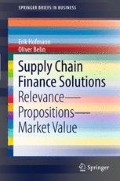Abstract
Working capital and the cash-to-cash cycle are important indicators to reveal supply chain efficiencies. Thereby, the objective is to balance and optimize the amount of working capital to successfully manage a company. Until recently traditional approaches were used to improve working capital mainly focusing on a single company. In contrast, the Supply Chain Finance approach provides opportunities to improve working capital for all parties involved in a supply chain.
Access this chapter
Tax calculation will be finalised at checkout
Purchases are for personal use only
Notes
- 1.
"Economic Value Added" (EVA®) is a registered trademark of Stern Stewart & Co
References
Bhalla VK (2005) Working capital management. Anmol Publications, New Delhi
Callioni G, de Montros X, Slagmulder R, van Wassenhove L, Wright L (2005) Inventory-driven costs. Harvard Bus Rev 83(3):135–140
Cheng NS, Cravens K, Lamminmaki D, Pike R (2005) Trade credit terms: asymmetric information and price discrimination evidence from three continents. J Bus Finance Account 32(5/6):1197–1236
Emery DR, Finnerty JD (1997) Corporate financial management, 2nd edn. Prentice Hall, Upper Saddle River
Farris MT II, Hutchison PD (2003) Measuring cash-to-cash performance. Int J Logist Manag 14(2):83–91
Flood M (1952) On game-learning theory and some decision-making experiments. RAND research paper
García-Teruel PJ, Martínez-Solano P (2007) Effects of working capital management on SME profitability. Int J Manag Finance 3(2):164–177
Hofmann E, Locker A (2009) Value-based performance measurement in supply chains - a case study from the packaging industry. In: Production Planning & Control 20(1):68–81
Hofmann E, Kotzab H (2010) A supply chain-oriented approach of working capital management. J Bus Logist (forthcoming) 31(2):305–330
Hofmann E, Maucher D, Piesker S, Richter S (2011) Ways out of the working capital trap: empowering self-financing growth through modern supply Management. Springer
Howorth C, Westhead P (2003) The focus of working capital management in UK small firms. Manag Account Res 14(2):94–111
Jose ML, Lancaster C, Stevens JL (1996) Corporate returns and cash conversion cycles. J Econ Finance 20(1):33–46
Mian SL, Smith CW (1992) Accounts receivable management policy: theory and evidence. J Finance 47(1):169–200
Moss JD, Stine B (1993) Cash conversion cycle and firm size: a study of retail firms. Manag Finance 19(8):25–38
Ng CH, Smith JK, Smith RL (1999) Evidence on the determinants of credit terms used in interfirm trade. J Finance 54(3):1109–1129
Pike R, Cheng NS, Cravens K, Lamminmaki D (2005) Trade credit terms: asymmetric information and price discrimination evidence from three continents. J Bus Finance Account 32(5):1197–1236
PricewaterhouseCoopers (2009) Demystifying supply chain finance—insights into the what, why, how, where and who. http://www.pwc.com/en_US/us/issues/surviving-the-financial-downturn/assets/supply_chain_finance.pdf. Accessed 09 Apr 2010
Rafuse ME (1996) Working capital management. An urgent need to refocus. Manag Decis 34(2):59–63
Rappaport A (1999) Shareholder value. Schäffer-Poeschel Verlag, Stuttgart
Reason T (2005) Capital ideas: the 2005 working capital survey. CFO Mag 21(12):88–92
Reider R, Heyler PB (2003) Analyzing sales for better cash flow management. J Corp Account Finance 15(1):15–25
Richards VD, Laughlin EJ (1980) A cash conversion cycle approach to liquidity analysis. Financial Manag 9(1):32–38
Ross SA, Westerfield RW, Jaffe J (2005) Corporate finance, 7th edn. McGraw-Hill, Boston
Scherr FC (1989) Modern working capital management—text and cases. Prentice-Hall, Englewood Cliffs
Shin H-H, Soenen L (1998) Efficiency of working capital management and corporate profitability. Financial Pract Educ 8(2):37–45
Shulman J, Cox R (1985) An integrative approach to working capital management. J Cash Manag 5(6):64–67
Soenen LA (1993) Cash conversion cycle and corporate profitability. J Cash Manag 13(4):53–58
Author information
Authors and Affiliations
Corresponding author
Rights and permissions
Copyright information
© 2011 Springer-Verlag Berlin Heidelberg
About this chapter
Cite this chapter
Hofmann, E., Belin, O. (2011). Relevance of WCM and Its Weaknesses. In: Supply Chain Finance Solutions. SpringerBriefs in Business. Springer, Berlin, Heidelberg. https://doi.org/10.1007/978-3-642-17566-4_2
Download citation
DOI: https://doi.org/10.1007/978-3-642-17566-4_2
Published:
Publisher Name: Springer, Berlin, Heidelberg
Print ISBN: 978-3-642-17565-7
Online ISBN: 978-3-642-17566-4
eBook Packages: Business and EconomicsEconomics and Finance (R0)

